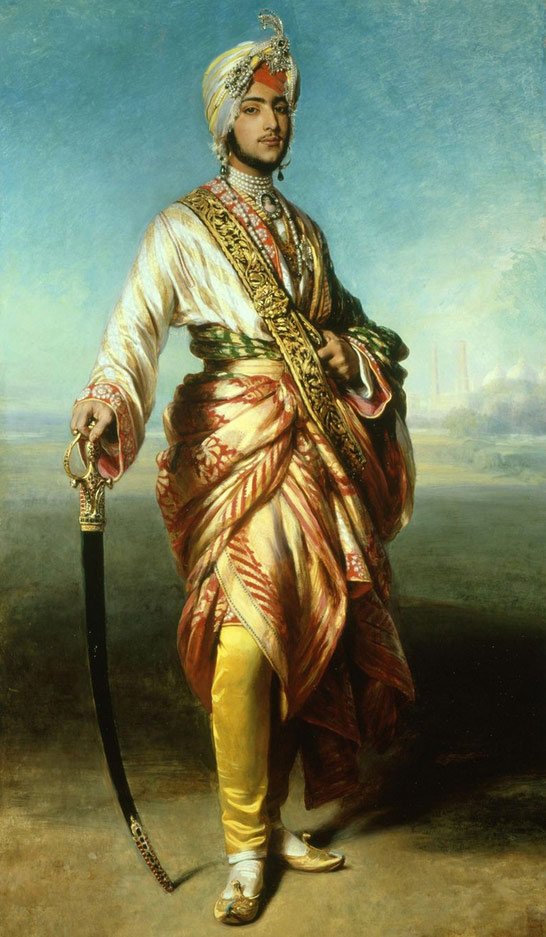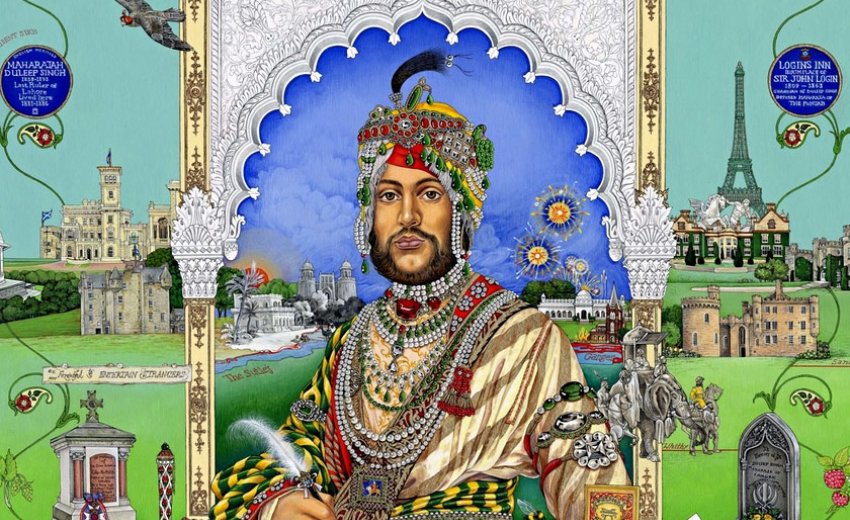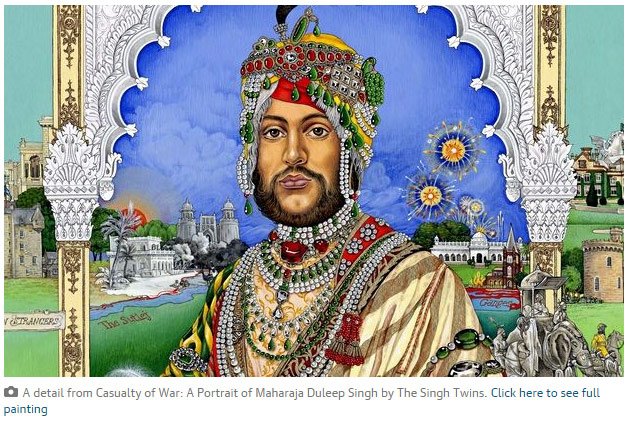He was deposed, brought to Britain in 1854, and paraded like a conquest of empire. Now two irreverent Sikh artists have decided to tell the full heartbreaking and extraordinary story of the ‘Black Prince of Perthshire’
The year is 1854, the British empire is at its height, and Queen Victoria has just commissioned a portrait of Britain’s first resident Sikh. He is Duleep Singh, the last Maharaja of the Sikh empire, forced as a boy to surrender his sovereignty to Britain and separated from his mother at the age of 10. Now in his teens, he has just been brought to the UK.
Duleep Singh is as much a conquest of empire as the famed Koh-i-Noor diamond he is claimed to have “gifted” to the crown. He is procured, coveted, treasured and locked away like a jewel. As the painting progresses over two sittings in July, the Queen notes that her court artist, Franz Xaver Winterhalter, is “in ecstasies at the beauty and nobility of the bearing of the young Maharaja”. Victoria is equally captivated by the “grace and dignified manner” of the “extremely handsome” young man. “I always feel so much for these deposed Indian princes!” she says.
The resulting portrait – still at Osborne House on the Isle of Wight, where Duleep Singh spent many summers with Victoria, Albert and their children – is a masterpiece of imperial fantasy and colonial projection. Here is the deposed and exiled Sikh prince as exoticised romantic hero, placed in an imaginary landscape flooded with light, wearing full Indian dress, turban and a jewelled miniature of Queen Victoria.
The reality was far darker. The Maharaja was a war trophy, a political pawn and an effective prisoner of the state. Under the guardianship of a Scots couple – Sir John and Lady Login, who he referred to as his parents and who converted him to Christianity, as well as instilling in him a love of the Highlands – Duleep Singh had little choice but to become the man the British wanted him to be. He was never permitted to return to the Punjab, despite increasingly desperate attempts. His life was extraordinary: he became a Victorian gent, an English aristocrat, the “Black Prince of Perthshire”, the fourth-best shot in Britain, a dabbler in Tory politics, a dangerous threat to British imperialism, and finally the disenchanted Sikh rebel who died alone and impoverished in a hotel room in Paris.

Now, 160 years later, another very different portrait has been commissioned, this time by the National Museum of Scotland, for an exhibition exploring relations between Britain and India over the past two centuries. The artists who made Casualty of War: A Portrait of Maharaja Duleep Singh are Amrit and Rabindra Singh, otherwise known as the Singh Twins, a rebellious pair of British Sikh women in their 40s who subvert the style of Indian miniatures and sign off their paintings as one. Their work is highly decorative, traditional, modern, accessible – and cheeky. It’s sort of Grayson Perry-ish, but Indian. And yes, they are twins.
“We’ve been making work about Duleep Singh since the 90s,” Amrit says. “His story is so tragic. He has become a figurehead for Sikhs, a poignant symbol of what we once had and lost.”
Duleep Singh’s jewellery and treasured possessions, acquired by the British at auction after his death and still highly contested, also feature in the exhibition. “Handling them was very sad for us,” says Amrit. “And exciting,” Rabindra adds. “If we could go back to any time in history, it would be to the Lahore court.”
“Yes,” says Amrit. “But there’s anger and resentment, too. You know: why are these things here? They tell the story of a man who surrounded himself with objects that somehow still encapsulated his identity. His life was filled with longing for his homeland, no matter how English and Christian he became. As British-born Sikhs, we can identify with that sense of loss, that pining for a heritage, that identity confusion. It’s why, for example, Duleep Singh kitted out his estate in Elveden in the classical Indian marble style. It’s beautiful and sad, as though he was trying to recreate his father’s court in the Suffolk countryside.”
We meet in Liverpool, where a clipper ship named after Duleep Singh was built, and where the twins’ father settled after arriving in Britain in 1947. This was the year of partition, and he was nine. The twins live and work together in the city, sharing a mobile phone and dressing identically. Today, they greet me in the entrance hall of the grand Walker gallery, where they had a major retrospective in 2005, by popping out from either side of a pillar. They’re wearing matching saris and slippers, with the same meticulously drawn lines of kohl around their eyes, and matching blue umbrellas in their right hands.

“When we studied, we were taught that self-expression and individualism were the be-all and end-all of modern art,” Rabindra says. “We were criticised for not being different enough. So we decided to challenge this western ideal of individuality by being the same.”
“Our individuality is our sameness,” says Amrit. And then they both laugh the same laugh.
Their painting takes the Winterhalter portrait as its template, then reimagines the Maharaja as he was never permitted to be: as ruler of his kingdom, in traditional finery, surrounded by objects that were surrendered to the British. It turns a statement of colonial might into a contemporary meditation on identity. “He never really got to live like this,” Amrit says. “The Winterhalter portrait depicts him as a nobleman, but we show him as even more than that – as the Maharaja he was supposed to be.”
Outside the gallery, in a city dominated by the hulking neoclassical buildings of empire, the twins point out St George’s Hall, which Queen Victoria called “worthy of ancient Athens”. Inside it is a Victorian painting of a royal wedding in which Duleep Singh can be made out in the congregation.
“His life was so complex,” says Amrit. “He always had people telling him what to do, who to be. He was moulded into a Christian gentleman, then would be asked to wear full Indian dress when paraded at Victoria and Albert’s parties. There was that sense that he would never truly be one of them, which British Asians can still identify with. But he also had a great affection for Britain, the Logins and Victoria.”
“There is no way of reconciling this man’s identity,” Rabindra says.
Amrit nods. “Or the history he represents.”


